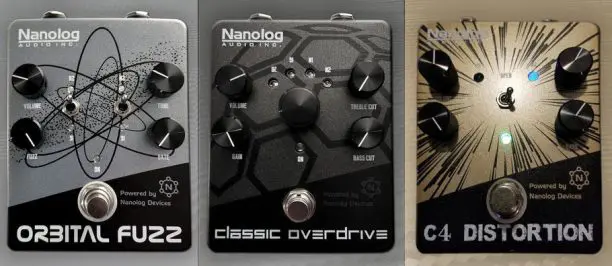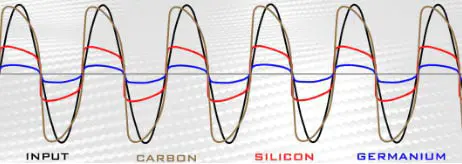
In recent years, a few companies have been working on new ways to create distortion (for musical purposes). Senior PhD researcher from the Canadian National Institute for Nanotechnology Adam Bergren has been on the forefront of this effort, collaborating in 2016 with Dr. Scientist to create the first guitar pedal built on a new carbon quantum tunneling technology: The Heisenberg Molecular Overdrive.
Shortly after, Adam created Nanolog Audio with fellow PhD researcher (and guitarist) Rick McCreery, with the intent to “give artists new inspirational tools to explore the carbon universe in pursuit of achieving the ultimate tone.”
At the 2018 NAMM show, the manufacturer unveiled the WaveFunction Overdrive, which adopted “carbon molecular junctions” technology that – according to Nanolog – “allow for a new palette of sounds not available with silicon diodes.”
This week, the company unveiled three new gain pedals based on the same technology – or an evolution of it: the Classic Overdrive, the C4 Distortion and the Orbital Fuzz, while the WaveFunction seems to have been discontinued.
You can check out the demo at the bottom of this post to make up your mind about Carbon-driven distortion, but those wondering how this technology works or what it promises to deliver should check out Nanolog’s homepage, which is entirely dedicated to that topic. Here’s a snapshot:
Nanolog Devices are made of carbon, and signal flow through the molecular layer creates a more robust and dynamic output than is possible with any traditional diode. Nanolog Devices conduct current in a smooth and constant fashion, where silicon and germanium diodes have “deadzones” which create immense compression and saturation of tone. In comparison, the carbon layer and quantum process in Nanolog’s technology results in a rich and full tone that highlights natural harmonics.

source: https://www.nanologaudio.com/
Interestingly, Nanolog is operating very much like a public research lab, committed to share the details about this technology with other builders and innovators.
We asked Adam a few questions about this carbon adventure:
What made you think of applying carbon technology to distortion?
I am a long-time tone hunter, and I was looking to improve the sound of a BOSS SD-1, pretty much as a hobby. Once I realized how clipping diodes worked in these kinds of circuits, I immediately connected things with the devices I have been studying as a scientist for many years! Thankfully, these studies were carried out using a platform for making reliable and robust devices. So, I guess you could say I wanted to try improving the tonal range and dynamics of my guitar rig, and create a pedal with an interesting new set of possible tone options. Connecting the science I was working on the pedals I was using to creating new possibilities was really a chance encounter, a case of being aware and passionate about two seemingly unrelated things (guitar effects pedals and molecular electronics)!
How did the technology change since the pedal you released in collaboration on with Dr. Scientist in 2016?
The Dr. Scientist collaboration was really designed just to see if the idea would work at all! At the time, we were not sure if it would be a cool sound or what, and we also didn’t have a way to even make devices that could be connected to circuitry. So the initial project was aimed at figuring these things out! The NINT Molecular Clipping Prototype was the basis for the very first molecular electronics product, the Heisenberg Molecular Overdrive, and this was because the Prototype sounded really cool!
What has changed since then is several things- we’ve explored using the Carbon devices in other circuit types, as the prototype used three different clipping circuits out of a possible ton of options! Our current line up covers a wider range of circuits. As well, we have gotten much better at making Nanolog Devices, as we’ve had to scale things up from making one device at a time to making and packaging several thousand, all while trying our best to keep the technology affordable and accessible.
Why did you decide to include old-style silicon and germanium diodes options next to the new carbon devices in all your new models?
There are a few reasons for this. First, I felt it was important to get across the message that there really is no “better” when it comes to gear for expressing musical ideas, there is just “different.” So I wanted to create products that would enable the user to decide what type of tone they are after. Sometimes, an open, crunchy, compressed, and crystalline bite that you get with Si fits the bill perfectly. In other cases, the Carbon devices complement what is trying to be expressed nicely. A second reason is to be sure and show people what the Carbon devices can do. Differences in tone with clipping device options can be subtle, but sometimes it is just what is needed to obtain that perfect tonal option. So really, I wanted to enable those tone hunters to understand what can happen with different types of clipping options so that they can decide what works for their music. Finally, there is an element of “classic” sounds to be had, many of which originated in Si or Ge clipping, so having those options is great!
All this said, we are thinking about products that would just have Carbon clipping options, perhaps in smaller, more minimalistic pedals, so who knows- stay tuned to see what we come up with!
Carbon clipping is presented as producing a (way) more dynamic distortion than silicon or germanium, but while dynamics have always been important in overdrive pedals, fuzz and distortion have always been a “full-on” kind of effect. Do your fuzz and distortion pedals behave more like a very dynamic overdrive on softer parts, without losing their tonal quality?
This is a great question! What happens with Carbon clipping in Distortion (for example, our C4 Distortion) is indeed a bit more dynamics. In addition to this, there is a larger presence of the lower-mids, providing a generally “larger” sound. I do find myself that there is more going on with pick attack using the Carbon clipping in Distortion, so I appreciate that for sure in the C4.
In terms of Fuzz, I wouldn’t really say I find it is a dynamic effect with the carbon clipping as much as a warmer sound that just gets huge. In comparison to Si in our Orbital Fuzz, I find the Carbon N2 setting to provide a warm, woolly, dark, and demented sort of sound, and often this enables me to turn up the tone knob, because I find that the highs aren’t so piercing. So it can really help cut through the mix without being ear-fatiguing that can happen with all that high end. But a reminder here again- these are things for the tone hound to obsess over, and everyone should do whatever works for them!
Can carbon be applied to any other effects besides gain ones?
Not directly, no. These devices provide clipping, so it could be used in cases where a light amount of clipping is needed, or where just a boost is required (that is, very low gain cases). But things like Reverb, Chorus, Delay, etc., would not directly use the Carbon devices. I do think it would be cool to have delay with a Carbon-based Gain circuit operating in the decay or something, so I am sure someone will find ways to make use of them in cool effects besides overdrive/distortion/fuzz!
Manufacturers are normally very “jealous” of their innovative circuit (hence the word “proprietary”) but on your site you guys say that you are committed to sharing this technology with other builders, why is that?
Our goal is to enable people to create great music, and inspire people to interact with their gear to obtain enjoyment out of the process. There is just no way we as a small company can make enough products to maximize the benefit of the Carbon clipping. We are happy to collaborate with companies to create new products, and we have been doing this in some cases already (Rose Pedal Electric Effects, Southampton, and Rougarou, and a few others have been working with them). There are just so many great builders out there, and the number of circuits that could be used is staggering! Maintaining a collaborative posture is important, because people can come up with all kinds of great things if they are given the right tools, and that is what a Nanolog Device is- a tool to create really cool rock and roll sounds!
Here’s the Reverb.com demo of all three pedals!






















